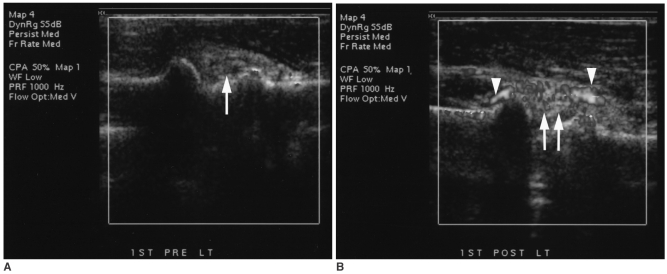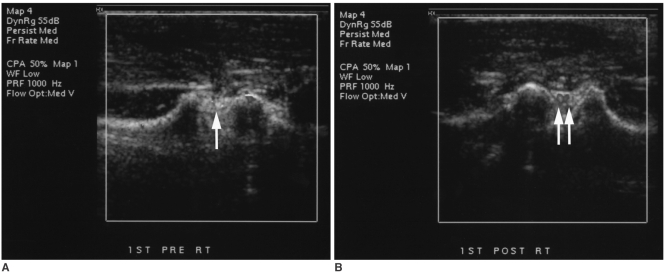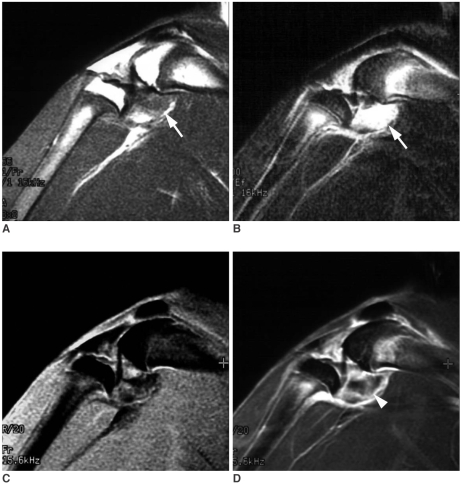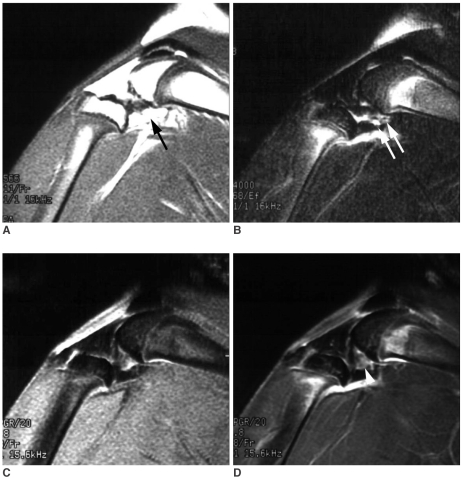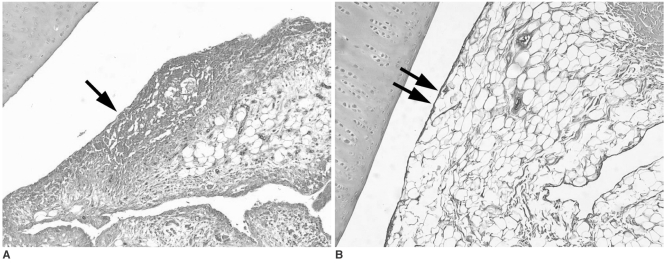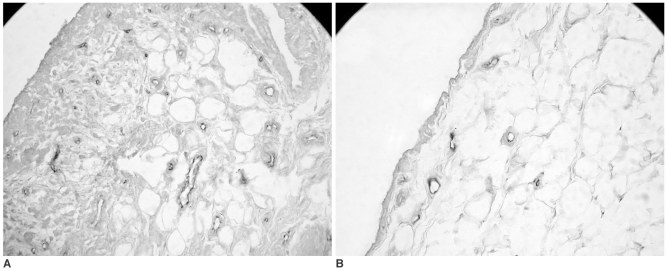Abstract
Objective
To validate contrast-enhanced power Doppler ultrasonography (PD US) for the evaluation of synovial vascularity in an arthritic rabbit knee model in correlation with MR and histological findings.
Materials and Methods
Power Doppler ultrasonography was performed for carrageenin-induced arthritic left knee and control right knee of 13 rabbits, first without and then with sonic contrast agent enhancement (Levovist, Schering, Berlin Germany), followed by gadolinium-enhanced MR imaging. Synovial vascularity was quantitatively assessed by calculating the color pixel area in power Doppler sonography using a computer-aided image analysis program and by grading the enhancement on MR images: grade 1, enhancement of knee joint is less than one-third of the area; grade 2, one-third to two-thirds enhancement; and grade 3, more than two-thirds enhancement. Microvessel density (MVD) was measured on slides stained immunohistochemically for CD31 antigen for histological assessment.
Results
The mean area of color pixels in PD US changed from 4.37 to 16.42 mm2 in the arthritic knee after enhancement (p < 0.05), whereas it changed from 0.77 to 2.31 mm2 in the control knee (p < 0.05). Arthritic knees had greater power Doppler signal than control knees both before and after contrast administration (p < 0.05). The average MVD was 88 in arthritic knees and 46 in control knees. MVDs correlated with color pixel areas of contrast-enhanced power Doppler imaging in arthritic knees. In MR grading of arthritic knees, five were grade 2 and eight were grade 3. MVD and PD US revealed no significant difference between grade 2 and 3 arthritic knees (p > 0.05).
Conclusion
Sonic contrast-enhanced PD US improves the visualization of synovial vascularity and allows quantitative measurement in experimentally induced rabbit arthritic knees.
Keywords: Arthritis; Joints, US; Synovitis; Ultrasound (US), Power Doppler studies; Magnetic resonance (MR); Arthrtis, animal studies
Synovitis is sometimes overlooked in clinically silent, asymptomatic patients with early arthritis (1). American College of Rheumatology (ACR) criteria for the diagnosis of rheumatoid arthritis (RA) have been used widely, but these criteria are not sufficiently effective for detecting early RA (2, 3). Synovial biopsy may reveal the typical histologic features of RA, but it does not provide specific features for RA and is rarely used because of its invasiveness (4). However, early diagnosis of RA is considered an important issue in order to prevent joint deformity and disability.
Regarding the imaging strategy, ultrasonography (US) and magnetic resonance imaging (MRI) both have an increasing role in the early detection and follow-up in RA because of their quantitative measurement capabilities (5, 6). Enhanced MR imaging is more informative than conventional MR imaging. Power Doppler ultrasonography (PD US) has also been useful for evaluating synovial vascularity (7-12). Synovial hyperemia is mostly accompanied by increased vascularity in RA, and the progression or regression of alterations in vascularity can be monitored during therapeutic follow-up. Regardless of the PD US application, synovitis can barely be depicted in cases with mildly increased vascularity. To improve Doppler sensitivity, an US contrast agent has been introduced that can lower the color effect visibility threshold and improve sensitivity for the weak flow in tissues. US is cheaper and easier to operate than MR imaging; however, there have only been a few studies about the evaluation of synovial vascularity in arthritis using sonic contrast agent-enhanced US.
The purpose of this study is to validate contrast-enhanced PD US for evaluation of synovial vascularity in experimentally induced knee arthritis in rabbits by comparing PD US with MR and histologic findings.
MATERIALS AND METHODS
The study was approved by the institutional Committee on Animal Research. Arthritis was induced in the left knee of 13 white New Zealand rabbits (mean weight, 3 Kg). Carrageenin (Sigma, C1867), a mucopolysaccharide, has been used to generate inflammatory arthritis in animal models (13-17). As carrageenin provokes a local antigenic inflammatory response, intra-articular injection of carrageenin resembles the pathologic features seen in rheumatoid arthritis (18-20). After shaving the anterior knee, 0.3 ml of 2% (w/v) carrageenin was injected into the left knee twice using a 26-gauge needle at a one-week injection interval. The right knee of the rabbit was used as the control knee.
Power Doppler US (ATL 3000, 5-12 MHz linear transducer, Bothell, WA), first without and then with a sonic contrast agent (Levovist, Schering, Berlin, Germany) injection via an ear vein, was performed seven days after the second intra-articular injection of carrageenin. During the imaging procedures, rabbits were anesthetized with ketamine (35 mg/kg) and xylazine (5 mg/kg) injected intramuscularly. US was performed by a musculoskeletal radiologist. With the rabbit in the lateral decubitus position, posterior joint spaces were evaluated as they were more accessible than anterior joint spaces. The imaging plane and machine settings (55 dB dynamic range, medium persistence, medium frame rate, low wall filter, 1,000 Hz pulse repetition frequency, flow optimization: medium vein, 50-70% CPA) were identical throughout all US examinations. The sonic contrast agent was prepared in a standard manner. Over 5 seconds, 0.5 mL of sonic contrast was slowly infused at a concentration of 200 mg/ml. The arthritic left knees were assessed first, followed by evaluation of control knees. Areas of highest vascularity were selected for both knees. The arthritic knee was then evaluated with sonic contrast agent under the same US parameters (Fig. 1). Five minutes after completing the left knee, the right knee was evaluated at the same location as the pre-contrast scanning slice with repeated injection of the contrast agent (Fig. 2).
Fig. 1.
Ultrasound images of carrageenin-induced arthritis of the rabbit.
A, B. Power Doppler ultrasound examinations before (A) and after (B) ultrasound contrast injection in the arthritic left knee show expansion of the joint capsule and heterogeneous echogenicity in the posterior joint space (arrow in A). Power Doppler signals in the joint are faintly visible before contrast agent injection, except for the penetrating intraosseous signal (score = 0.45 mm2). After the contrast agent injection, Power Doppler signals increase in extent in the posterior joint space (double arrows in B) and signals of popliteal vessels (arrowheads in B) appear prominently (score = 30.78 mm2).
Fig. 2.
Ultrasound images of control right knee of the rabbit.
A, B. Power Doppler ultrasound examinations before (A) and after (B) ultrasound contrast agent injection in the control knee show faint power Doppler signals of the posterior joint space (arrow in A) before contrast agent injection (score = 0.74 mm2) and a few intra-articular signals (double arrows in B) after contrast enhancement (score = 2.57 mm2).
MR imaging was performed on a 1.5T MR scanner (Signa, General Electric, Milwaukee, WI) using bilateral TMJ coil (GE, Milwaukee, WI) immediately after US. The images were acquired in the sagittal plane using the following three pulse sequences: T1-weighted spin echo (TR/TE = 600/14, 8 cm FOV, 3 mm slice thickness with no gap, 256×256 matrix, 1 NEX); fat-suppressed T2-weighted fast spin echo (TR/TE = 4000/68, 8 cm field-of-view [FOV], 3 mm slice thickness with no gap, 256×256 matrix, 2 NEX, 8 echo train length); and pre- and post-gadolinium-enhanced three-dimensional fat-suppressed, fast spoiled gradient echo (3D FS-FSPGR; TR/TE = 21.8/2.8, 20° flip angle, 256×192 matrix, 8-10 FOV, 2 mm slice thickness with no gap, 2 NEX, 5 minute 2 second acquisition time, 0.1 mmol/kg of Gd-DTPA [Magnevist, Schering, Berlin, Germany]).
Pre- and post-contrast PD images were assessed by analyzing the color pixel areas using a free software program called Computer-aided Image Analysis (Sonic, Seoul, Korea). This software allows manual segmentation to determine the areas of PD signals in the FOV; a musculoskeletal radiologist oversaw all processing.
MR contrast enhancement was assessed in pre- and post-contrast 3D FS-FSPGR images. High signal change in the knee joint was regarded as enhancement. Intra-articular enhancement was graded at each knee joint: grade 1, enhancement of less than one-third of the knee joint area; grade 2, one-third to two-thirds enhancement; and grade 3, more than two-thirds enhancement.
After all US and MR examinations, the rabbits were killed with an overdose of ketamine and xylazine. Both hind legs were immediately removed and the knee joints were fixed in phosphate-buffered formalin after dissection and decalcification. Hematoxylin and eosin staining and immunohistochemical staining for CD31 antigen were performed, and histologic evaluations were taken. Anti-CD31 antibody (JC/70A, DAKO, Glostup, Denmark) staining was done using the LSAB method (Dako LSAB kit: Glostup, Denmark). The microvessel density (MVD) in each joint was regarded as the number of vessels in five different microscopic fields (×400) that presumably had high MVD areas.
Results were analyzed statistically using Wilcoxon Signed Rank test for pre- and post-contrast agent injection images, Mann-Whitney test for arthritic and control knees, and Spearman's correlation test for MVD and other parameters using SPSS 10.0 (SPSS Inc., Chicago, IL).
RESULTS
Ultrasonography of all arthritic left knees showed expansion of the joint capsule compared with control knee. Heterogeneous echogenicity in the posterior recess was demonstrated in all arthritic knees and there were no anechoic lesions; these echogenicities were more suggestive of debris or inflammatory tissues than pure joint effusion (Fig. 1). Bony abnormality was not observed on the surface of the femur or the tibia. Control knees had grossly normal US features (Fig. 2): the joint capsule was not distended, and no effusion or synovial proliferation was detected.
When the PD US was performed before and after sonic contrast-agent injection, the color pixel areas were increased after contrast injection. The mean color pixel areas changed from 4.37 (1.11-8.54) mm2 to 16.42 (9.42-30.78) mm2 in the arthritic knee (p < 0.05), whereas it changed from 0.77 (0-2.38) to 3.13 (1.44-7.56) mm2 in the control knee (p < 0.05). The arthritic knee had more PD signal than the control knee both before and after contrast administration (Table 1). The differences in the scores between the pre- and post-contrast images of the arthritic knee were 12.05 (4.1-30.33) and 2.36 (0.23-7.56) in the control knee; the arthritic knee had more significant contrast enhancement than the control knee (p < 0.01). In MR grading of arthritic knees, five were grade 2 and eight were grade 3 (Fig. 3). All control knees were grade 1 (Fig. 4). MVD and PD US revealed no significant difference between grade 2 and 3 in arthritic knees (p > 0.05).
Table 1.
Mean Areas (mm2) of Power Doppler Signals in Arthritic Knees and Control Knees of the Rabbit
Fig. 3.
MR images of carrageenin-induced arthritis of the rabbit.
Sagittal scan of T1-weighted image (A), fat-suppressed, fast spin-echo T2-weighted image (B), three-dimensional fat-suppressed, fast spoiled gradient-echo (3D FS-FSPGR) image before contrast enhancement (C), and 3D FS-FSPGR image after contrast enhancement (D) show joint effusion with posterior joint capsular distension (arrow in A and B) and thick contrast enhancement at the posterior margin of the joint space on the 3D FS-FSPGR image (arrowhead in D, grade 2).
Fig. 4.
MR images of the control right knee of the rabbit.
Sagittal scan of T1-weighted image (A), fat-suppressed, fast spin-echo T2-weighted image (B), three-dimensional fat-suppressed, fast spoiled gradient echo (3D FS-FSPGR) image before contrast enhancement (C), and 3D FS-FSPGR image after contrast enhancement (D) show no abnormal intra-articular lesions. Note the prominent intra-articular fat on T1WI (arrow in A), a few high signals on T2WI (double arrows in B), and little contrast enhancement on 3D FS-FSPGR image (arrowhead in D, grade 1).
Histopathology revealed synovial hypertrophy and aggregation of foamy macrophages in the subsynovial layer of arthritic knee (Fig. 5). The average MVD in arthritic knees was 88 (54-129) and 46 in control knees (39-62) (Fig. 6). The MVD only correlated with the color pixel areas of contrast-enhanced PD imaging in the arthritic knees (p < 0.05).
Fig. 5.
Histology (Hematoxylin & Eosin staining, ×100)
A. Arthritic knee shows marked synovial hypertrophy (arrow) and aggregation of foamy macrophages and lymphocytes in the subsynovial layer.
B. Control knee shows an intact synovial membrane without hypertrophy (double arrows).
Fig. 6.
Immunohistochemical staining for CD 31.
A. Arthritic knee shows many vessels in synovial and subsynovial layers (in brown).
B. Control knee shows a few vessels in synovial and subsynovial layers.
DISCUSSION
Early diagnosis of inflammatory arthritis is important because early, aggressive treatment may reduce long-term disability (21). For early detection of synovial inflammatory changes on conventional radiography (22-27), clinical examination and laboratory tests are limited in their usefulness (28, 29). Recently, MRI and US have improved the sensitivity for early detection of RA (11, 12). Hyperplastic and locally invasive synovia, inflammatory infiltrates, fibroblast proliferation, and intense neovascularization are common histological findings of RA. MRI provides useful information on soft tissue changes, bone destruction (erosion), bone marrow edema, and joint effusion; it also contributes to the evaluation of prognosis for RA (5, 30, 31). Although MRI is a powerful tool for the evaluation of synovitis with easy detection of synovial hypertrophy with contrast administration, the high costs, long examination times, and limited evaluation of only one anatomic lesion at a time may restrict the use of MRI for the evaluation of RA, especially in follow-up examinations (5, 11).
US is also considered a promising tool for detecting morphological changes in RA. It can detect synovial changes earlier, even in asymptomatic arthritis (1, 32), and it can reveal bone erosion, although the sound can not penetrate the cortex (12, 33). US may be superior to conventional radiography or MRI in certain situations, for instance, detection of small bone erosions (34). So, US has been often used as a complementary tool in the clinic to evaluate high-risk patients with inflammatory arthritis who do not have abnormalities on radiography (34).
Vascularization and angiogenesis develop in the pannus of RA because blood vessels are needed to recruit leukocytes or to provide nutrients and oxygen to starved tissue (35). Weber and De Bandt suggested that endothelial cell proliferation might be the inciting factor, and that persistent angiogenesis was a major factor in the chronicity of rheumatoid synovitis (36). With advances in MRI and US, much concern has been given to assessing angiogenesis and vascularity of RA.
With PD US, in particular, it is possible to assess the vascularity of synovitis (7). PD US correlates with histological findings in RA, proving its validity for qualitative evaluation of RA (37). However, PD is limited in its ability to detect slowly flowing vessels and small vessels. To improve the signal from weak tumor vascularity, the use of an US contrast agent was introduced. In a few recent studies, US contrast agent has been used for synovitis and proved to be useful for evaluating synovial vascularity (38, 39). The US contrast agent improved the echo enhancement from synovial vessels, which correlated with MRI data (38) and clinical grouping (39). However, these studies were designed for qualitative assessment. In contrast to previous studies, our study quantitatively measured the synovial vessels through computer-aided color-pixel counting. The use of an US contrast agent significantly increased the vascular signal areas in both arthritic and control knees. Moreover, it also increased the vascular yield in arthritic knees more than in control knees. When compared with control knees and correlated with MRI and MVD data, quantitative evaluation of PD US using a contrast agent allowed for the evaluation of synovial vascularity in cases of synovitis. Szkudlarek et al. (40) reported that contrast-enhanced PD US at the metacarpophalangeal joints did not increase the sensitivity for detecting rheumatoid arthritis; all six patients who did not have pre-contrast PD signal also did not show PD signal after US contrast agent administration. However, Klauser et al. (39) demonstrated that contrast agent administration significantly improved the detection of color flow signals in the finger joints of patients with RA. Fiocco et al. (41) reported that contrast-enhanced PD US in knee joints was more useful than the unenhanced PD US, showing higher sensitivity and more reproducible PD signal scores. In our study, all arthritic knees had PD signals. Even in control knees, the three that did not have pre-contrast power Doppler signal manifested post-contrast PD signal. Szkudlarek et al. (40) did not correlate their data with histologic findings, whereas Fiocco et al. (41) performed arthroscopic correlation, and histological correlation was done in our study. MVDs of the joint only correlated with post-enhancement PD US images in arthritic knee. Thus, post-contrast enhancement PD US images are important for evaluating angiogenesis.
The variable results of studies using US contrast agent are thought to be due to differences in joint size, numbers of examinations, selection criteria, Doppler techniques, and joint diseases (42). The depth of the target area in Doppler examination is also important because the sensitivity is affected by penetration depth of lowest detectable velocity (43). Human knee joint is deeper than superficial joints, so the detection of PD or color Doppler signals in the knee joint will be lower than that in hand and finger joints. And the curved or linear transducers used in many US scanners had different Doppler performance (43). Variation of vascularity in each joint might also affect the results. Thus, further controlled evaluations will be required to assess the usefulness of the contrast-enhanced PD US.
In our study, contrast-enhanced US is superior to MR for the evaluation of synovial vascularity as an indicator of synovitis. Many studies have evaluated MR and color Doppler or PD US in rheumatoid arthritis; some reveal comparable results with MR and US (38, 44, 45), whereas some are superior at US (46) or at MR evaluation (47). Magarelli et al. (38), Backhaus et al. (46), and Wamser et al. (47) studied contrast-enhanced PD US and MRI for the evaluation of synovitis, but reported different results. Backhaus et al. (46) reported that contrast-enhanced US was more sensitive than MRI in the detection of synovitis and tenosynovitis. In contrast, contrast-enhanced US was not as sensitive as MR in the study by Wamser et al. (47), where they evaluated four anatomic locations of the shoulder joint with a single bolus injection. However, the time of evaluation in contrast-enhanced PD US with Levovist is limited because of rapid destruction of microbubbles at high mechanical index, which decreases signal intensity with time (48). As a result, evaluation of multiple anatomic locations with a single contrast injection might decrease the sensitivity for microbubble detection. To overcome this problem, repeated injection of US contrast agent can be applied, as in our study, and continuous or slow infusion of US contrast agent (9, 49) and application of third generation of US contrast agents (50, 51) can also help.
US contrast agent has the potential to act as a macromolecular agent that could evaluate the perfusion and hemodynamics of soft tissues or tumors. The mean molecular diameter of Levovist is large, approximately 3 µm (50), and no extravasation into the surrounding tissue was demonstrated (52), which indicates that Levovist acts as a true intravascular contrast agent. Contrast-enhanced MR imaging may also provide information on vascular perfusion and permeability (53, 54). However, the MR contrast agent Gd-DTPA is easily extravasated and is not a true intravascular agent (55).
MR evaluation of synovial vascularity in our arthritic model was based on assessing the enhancement region. Enhancement grading is not a quantitative method, but a semi-quantitative method. This could be the reason why MR evaluation correlated less with PD US and histological evaluation. Dynamic evaluation of synovitis would better correlate with histologic evaluation, as shown in inflammatory arthritis (30). Thus, more elaborate MRI techniques are required for the evaluation of synovitis.
The use of a sonic contrast agent has some limitations, i.e., the blooming artifact after injection, signal changes due to patient movement, restricted scanning time because PD US detects the destroyed microbubbles, increase in systolic peak velocity, and high-intensity transient signals (38, 50). Recently, new US contrast agents have been introduced for low mechanical index imaging and for relatively longer examination times (50, 51).
In summary, contrast-enhanced PD US helps quantify and detect synovial inflammation in the arthritic knee model of the rabbit by showing increased PD signal compared to the pre-contrast imaging of the arthritic knee and the post-contrast imaging of the control knee.
Footnotes
This work was supported by Korea Research Foundation Grant (KRF-2003-003-E00158).
References
- 1.Pando JA, Duray P, Yarboro C, Gourley MF, Klippel JH, Schumacher HR. Synovitis occurs in some clinically normal and asymptomatic joints in patients with early arthritis. J Rheumatol. 2000;27:1848–1854. [PubMed] [Google Scholar]
- 2.Harrison BJ, Symmons DP, Barrett EM, Silman AJ. The performance of the 1987 ARA classification criteria for rheumatoid arthritis in a population based cohort of patients with early inflammatory polyarthritis. American Rheumatism Association. J Rheumatol. 1998;25:2324–2233. [PubMed] [Google Scholar]
- 3.Schumacher HR, Pessler F, Chen LX. Diagnosing early rheumatoid arthritis (RA). What are the problems and opportunities? Clin Exp Rheumatol. 2003;21(suppl. 31):S15–SS1. [PubMed] [Google Scholar]
- 4.Saaibi DL, Schumacher HR., Jr Percutaneous needle biopsy and synovial histology. Baillieres Clin Rheumatol. 1996;10:535–554. doi: 10.1016/s0950-3579(96)80048-3. [DOI] [PubMed] [Google Scholar]
- 5.Ostergaard M, Szkudlarek M. Imaging in rheumatoid arthritis - why MRI and ultrasonography can no longer be ignored. Scand J Rheumatol. 2003;32:63–73. doi: 10.1080/03009740310000058. [DOI] [PubMed] [Google Scholar]
- 6.Szkudlarek M, Court-Payen M, Jacobsen S, Klarlund M, Thomsen HS, Ostergaard M. Interobserver agreement in ultrasonography of the finger and toe joints in rheumatoid arthritis. Arthritis Rheum. 2003;48:955–962. doi: 10.1002/art.10877. [DOI] [PubMed] [Google Scholar]
- 7.Newman JS, Laing TJ, McCarthy CJ, Adler RS. Power Doppler sonography of synovitis: assessment of therapeutic response-preliminary observations. Radiology. 1996;198:582–584. doi: 10.1148/radiology.198.2.8596870. [DOI] [PubMed] [Google Scholar]
- 8.Walther M, Harms H, Krenn V, Radke S, Kirschner S, Gohlke F. Synovial tissue of the hip at power Doppler US: correlation between vascularity and power Doppler US signal. Radiology. 2002;225:225–231. doi: 10.1148/radiol.2251011272. [DOI] [PubMed] [Google Scholar]
- 9.Carotti M, Salaffi F, Manganelli P, Salera D, Simonetti B, Grassi W. Power Doppler sonography in the assessment of synovial tissue of the knee joint in rheumatoid arthritis: a preliminary experience. Ann Rheum Dis. 2002;61:877–882. doi: 10.1136/ard.61.10.877. [DOI] [PMC free article] [PubMed] [Google Scholar]
- 10.Strouse PJ, DiPietro MA, Teo E-L, Doi K, Chrisp CE. Power Doppler evaluation of joint effusions: investigation in a rabbit model. Pediatr Radiol. 1999;29:617–623. doi: 10.1007/s002470050662. [DOI] [PubMed] [Google Scholar]
- 11.Wakefield RJ, Kong KO, Conaghan PG, Brown AK, O'Connor PJ, Emery P. The role of ultrasonography and magnetic resonance imaging in early rheumatoid arthritis. Clin Exp Rheumatol. 2003;21(5 Suppl 31):S42–S49. [PubMed] [Google Scholar]
- 12.Alasaarela E, Suramo I, Tervonen O, Lahde S, Takalo R, Hakala M. Evaluation of humeral head erosions in rheumatoid arthritis: a comparison of ultrasonography, magnetic resonance imaging, computed tomography and plain radiography. Br J Rheumatol. 1998;37:1152–1156. doi: 10.1093/rheumatology/37.11.1152. [DOI] [PubMed] [Google Scholar]
- 13.Day SM, Lockhart JC, Ferrell WR, McLean JS. Divergent roles of nitrergic and prostanoid pathways in chronic joint inflammation. Ann Rheum Dis. 2004;63:1564–1570. doi: 10.1136/ard.2003.017269. [DOI] [PMC free article] [PubMed] [Google Scholar]
- 14.Liggins RT, Cruz T, Min W, Liang L, Hunter WL, Burt HM. Intra-articular treatment of arthritis with microsphere formulations of paclitaxel: biocompatibility and efficacy determinations in rabbits. Inflamm Res. 2004;53:363–372. doi: 10.1007/s00011-004-1273-1. [DOI] [PubMed] [Google Scholar]
- 15.Hansra P, Moran EL, Fornasier VL, Bogoch ER. Carrageenan-induced arthritis in the rat. Inflammation. 2000;24:141–155. doi: 10.1023/a:1007033610430. [DOI] [PubMed] [Google Scholar]
- 16.van Dijke CF, Peterfy CG, Brasch RC, Lang P, Roberts TP, Shames D, et al. MR imaging of the arthritic rabbit knee joint using albumin-(Gd-DTPA)30 with correlation to histopathology. Magn Reson Imaging. 1999;17:237–245. doi: 10.1016/s0730-725x(98)00167-2. [DOI] [PubMed] [Google Scholar]
- 17.Katori M, Majima M, Harada Y. Possible background mechanisms of the effectiveness of cyclooxygenase-2 inhibitors in the treatment of rheumatoid arthritis. Inflamm Res. 1998;47(Suppl 2):S107–S111. doi: 10.1007/s000110050293. [DOI] [PubMed] [Google Scholar]
- 18.Gardner DL. Production of arthritis in the rabbit by the local injection of the mucopolysaccharide caragheenin. Ann Rheum Dis. 1960;19:369–376. doi: 10.1136/ard.19.4.369. [DOI] [PMC free article] [PubMed] [Google Scholar]
- 19.Uruchurtu Marroquin A, Ajmal M. Carrageenin-induced arthritis in the specific-pathogen-free pig. J Comp Pathol. 1970;80:607–611. doi: 10.1016/0021-9975(70)90059-9. [DOI] [PubMed] [Google Scholar]
- 20.Di Rosa M. Biological properties of carrageenan. J Pharm Pharmacol. 1972;24:89–102. doi: 10.1111/j.2042-7158.1972.tb08940.x. [DOI] [PubMed] [Google Scholar]
- 21.Breedveld FC, Dijkmans BA. Differential therapy in early and late stages of rheumatoid arthritis. Curr Opin Rheumatol. 1996;8:226–229. doi: 10.1097/00002281-199605000-00010. [DOI] [PubMed] [Google Scholar]
- 22.Brower AC. Use of the radiograph to measure the course of rheumatoid arthritis. The gold standard versus fool's gold. Arthritis Rheum. 1990;33:316–324. doi: 10.1002/art.1780330303. [DOI] [PubMed] [Google Scholar]
- 23.Watt I. Basic differential diagnosis of arthritis. Eur Radiol. 1997;7:344–351. doi: 10.1007/s003300050165. [DOI] [PubMed] [Google Scholar]
- 24.Ostergaard M, Gideon P, Sorensen K, Hansen M, Stoltenberg M, Henriksen O, et al. Scoring of synovial membrane hypertrophy and bone erosions by MR imaging in clinically active and inactive rheumatoid arthritis of the wrist. Scand J Rheumatol. 1995;24:212–218. doi: 10.3109/03009749509100876. [DOI] [PubMed] [Google Scholar]
- 25.Sharp JT. Radiologic assessment as an outcome measure in rheumatoid arthritis. Arthritis Rheum. 1989;32:221–229. doi: 10.1002/anr.1780320218. [DOI] [PubMed] [Google Scholar]
- 26.Kaye JJ. Arthritis: roles of radiography and other imaging techniques in evaluation. Radiology. 1990;177:601–608. doi: 10.1148/radiology.177.3.2243957. [DOI] [PubMed] [Google Scholar]
- 27.Resnick D. Rheumatoid arthritis and the seronegative spondyloarthropathies: Radiographic and pathologic concepts. In: Resnick D, editor. Diagnosis of bone and joint disorders. 4th ed. Philadelphia: Saunders; 2002. pp. 837–890. [Google Scholar]
- 28.Scott DL. European preferences in assessing rheumatoid arthritis. J Rheumatol. 1993;20:542. [PubMed] [Google Scholar]
- 29.Felson DT. Choosing a core set of disease activity measures for rheumatoid arthritis clinical trials. J Rheumatol. 1993;20:531–534. [PubMed] [Google Scholar]
- 30.Ostergaard M, Stoltenberg M, Lovgreen-Nielsen P, Volck B, Sonne-Holm S, Lorenzen I. Quantification of synovistis by MRI: correlation between dynamic and static gadolinium-enhanced magnetic resonance imaging and microscopic and macroscopic signs of synovial inflammation. Magn Reson Imaging. 1998;16:743–754. doi: 10.1016/s0730-725x(98)00008-3. [DOI] [PubMed] [Google Scholar]
- 31.Gaffney K, Cookson J, Blades S, Coumbe A, Blake D. Quantitative assessment of the rheumatoid synovial microvascular bed by gadolinium-DTPA enhanced magnetic resonance imaging. Ann Rheum Dis. 1998;57:152–157. doi: 10.1136/ard.57.3.152. [DOI] [PMC free article] [PubMed] [Google Scholar]
- 32.Naranjo A, Marrero-Pulido T, Ojeda S, Francisco F, Erausquin C, Rua-Figueroa I, et al. Abnormal sonographic findings in the asymptomatic arthritic shoulder. Scand J Rheumatol. 2002;31:17–21. doi: 10.1080/030097402317255318. [DOI] [PubMed] [Google Scholar]
- 33.Wakefield RJ, Gibbon WW, Conaghan PG, O'Connor P, McGonagle D, Pease C, et al. The value of sonography in the detection of bone erosions in patients with rheumatoid arthritis: a comparison with conventional radiography. Arthritis Rheum. 2000;43:2762–2770. doi: 10.1002/1529-0131(200012)43:12<2762::AID-ANR16>3.0.CO;2-#. [DOI] [PubMed] [Google Scholar]
- 34.Alarcon GS, Lopez-Ben R, Moreland LW. High-resolution ultrasound for the study of target joints in rheumatoid arthritis. Arthritis Rheum. 2002;46:1969–1970. doi: 10.1002/art.10310. author reply 1970-1971. [DOI] [PubMed] [Google Scholar]
- 35.Firestein GS. Etiology and pathogenesis of rheumatoid arthritis. In: Kelley WN, Ruddy S, Harris ED Jr, Sledge CB, editors. Textbook of rheumatology. 5th ed. Philadelphia: Saunders; 1997. pp. 851–897. [Google Scholar]
- 36.Weber AJ, De Bandt M. Angiogenesis: general mechanisms and implications for rheumatoid arthritis. Joint Bone Spine. 2000;67:366–383. [PubMed] [Google Scholar]
- 37.Walther M, Harms H, Krenn V, Radke S, Faehndrich TP, Gohlke F. Correlation of power Doppler sonography with vascularity of the synovial tissue of the knee joint in patients with osteoarthritis and rheumatoid arthritis. Arthritis Rheum. 2001;44:331–338. doi: 10.1002/1529-0131(200102)44:2<331::AID-ANR50>3.0.CO;2-0. [DOI] [PubMed] [Google Scholar]
- 38.Magarelli N, Guglielmi G, Di Matteo L, Tartaro A, Mattei PA, Bonomo L. Diagnostic utility of an echo-contrast agent in patients with synovitis using power Doppler ultrasound: a preliminary study with comparison to contrast-enhanced MRI. Eur Radiol. 2001;11:1039–1046. doi: 10.1007/s003300000650. [DOI] [PubMed] [Google Scholar]
- 39.Klauser A, Frauscher F, Schirmer M, Halpern E, Pallwein L, Herold M, et al. The value of contrast-enhanced color Doppler ultrasound in the detection of vascularization of finger joints in patients with rheumatoid arthritis. Arthritis Rheum. 2002;46:647–653. doi: 10.1002/art.10136. [DOI] [PubMed] [Google Scholar]
- 40.Szkudlarek M, Court-Payen M, Strandberg C, Klarlund M, Klausen T, Ostergaard M. Contrast-enhanced power Doppler ultrasonography of the metacarpophalangeal joints in rheumatoid arthritis. Eur Radiol. 2003;13:163–168. doi: 10.1007/s00330-002-1459-2. [DOI] [PubMed] [Google Scholar]
- 41.Fiocco U, Ferro F, Cozzi L, Vezzu M, Sfriso P, Checchetto C, et al. Contrast medium in power Doppler ultrasound for assessment of synovial vascularity: comparison with arthroscopy. J Rheumatol. 2003;30:2170–2176. [PubMed] [Google Scholar]
- 42.Klauser A, Frauscher F, Schirmer M. Value of contrast-enhanced power Doppler ultrasonography (US) of the metacarpophalangeal joints on rheumatoid arthritis. Eur Radiol. 2004;14:545–546. doi: 10.1007/s00330-003-1955-z. author reply 547-548. [DOI] [PubMed] [Google Scholar]
- 43.Browne JE, Watson AJ, Hoskins PR, Elliott AT. Validation of a sensitivity performance index test protocol and evaluation of colour Doppler sensitivity for a range of ultrasound scanners. Ultrasound Med Biol. 2004;30:1475–1483. doi: 10.1016/j.ultrasmedbio.2004.09.005. [DOI] [PubMed] [Google Scholar]
- 44.Terslev L, Torp-Pedersen S, Savnik A, von der Recke P, Qvistgaard E, Danneskiold-Samsoe B, et al. Doppler ultrasound and magnetic resonance imaging of synovial inflammation of the hand in rheumatoid arthritis: a comparative study. Arthritis Rheum. 2003;48:2434–2441. doi: 10.1002/art.11245. [DOI] [PubMed] [Google Scholar]
- 45.Szkudlarek M, Court-Payen M, Strandberg C, Klarlund M, Klausen T, Ostergaard M. Power Doppler ultrasonography for assessment of synovitis in the metacarpophalangeal joints of patients with rheumatoid arthritis: a comparison with dynamic magnetic resonance imaging. Arthritis Rheum. 2001;44:2018–2023. doi: 10.1002/1529-0131(200109)44:9<2018::AID-ART350>3.0.CO;2-C. [DOI] [PubMed] [Google Scholar]
- 46.Backhaus M, Kamradt T, Sandrock D, Loreck D, Fritz J, Wolf KJ, et al. Arthritis of the finger joints: a comprehensive approach comparing conventional radiography, scintigraphy, ultrasound, and contrast-enhanced magnetic resonance imaging. Arthritis Rheum. 1999;42:1232–1245. doi: 10.1002/1529-0131(199906)42:6<1232::AID-ANR21>3.0.CO;2-3. [DOI] [PubMed] [Google Scholar]
- 47.Wamser G, Bohndorf K, Vollert K, Bucklein W, Schalm J. Power Doppler sonography with and without echo-enhancing contrast agent and contrast-enhanced MRI for the evaluation of rheumatoid arthritis of the shoulder joint: differentiation between synovitis and joint effusion. Skeletal Radiol. 2003;32:351–359. doi: 10.1007/s00256-003-0632-2. [DOI] [PubMed] [Google Scholar]
- 48.Wei K, Skyba DM, Firschke C, Jayaweera AR, Lindner JR, Kaul S. Interactions between microbubbles and ultrasound: in vitro and in vivo observations. J Am Coll Cardiol. 1997;29:1081–1088. doi: 10.1016/s0735-1097(97)00029-6. [DOI] [PubMed] [Google Scholar]
- 49.Albrecht T, Urbank A, Mahler M, Bauer A, Dore CJ, Blomley MJ, et al. Prolongation and optimization of Doppler enhancement with a microbubble US contrast agent by using continuous infusion: preliminary experience. Radiology. 1998;207:339–347. doi: 10.1148/radiology.207.2.9577478. [DOI] [PubMed] [Google Scholar]
- 50.Correas JM, Bridal L, Lesavre A, Mejean A, Claudon M, Helenon O. Ultrasound contrast agents: properties, principles of action, tolerance, and artifacts. Eur Radiol. 2001;11:1316–1328. doi: 10.1007/s003300100940. [DOI] [PubMed] [Google Scholar]
- 51.Schneider M. Bubbles and microcirculatory disorders. Eur Radiol. 2001;11(Suppl 3):E1–E5. doi: 10.1007/pl00014127. [DOI] [PubMed] [Google Scholar]
- 52.Immer FF, Seiler AM, Aeschbacher BC, Mahler F, Saner H. Influence of the ultrasound contrast agent Levovist on human nailfold capillary microcirculation. Angiology. 2000;51:123–129. doi: 10.1177/000331970005100205. [DOI] [PubMed] [Google Scholar]
- 53.Turetschek K, Huber S, Floyd E, Helbich T, Roberts TP, Shames DM, et al. MR imaging characterization of microvessels in experimental breast tumors by using a particulate contrast agent with histopathologic correlation. Radiology. 2001;218:562–569. doi: 10.1148/radiology.218.2.r01fe37562. [DOI] [PubMed] [Google Scholar]
- 54.Kim TJ, Moon WK, Cha JH, Goo JM, Lee KH, Kim KH, et al. VX2 carcinoma in rabbits after radiofrequency ablation: comparison of MR contrast agents for help in differentiating benign periablational enhancement from residual tumor. Radiology. 2005;234:423–430. doi: 10.1148/radiol.2342031456. [DOI] [PubMed] [Google Scholar]
- 55.Turetschek K, Preda A, Novikov V, Brasch RC, Weinmann HJ, Wunderbaldinger P, et al. Tumor microvascular changes in antiangiogenic treatment: assessment by magnetic resonance contrast media of different molecular weights. J Magn Reson Imaging. 2004;20:138–144. doi: 10.1002/jmri.20049. [DOI] [PubMed] [Google Scholar]



